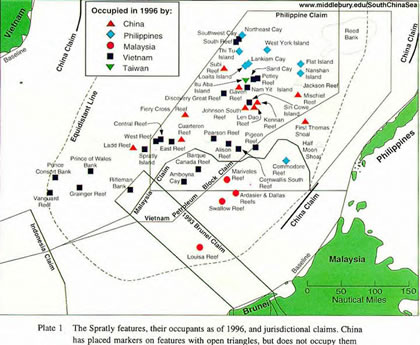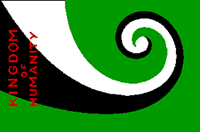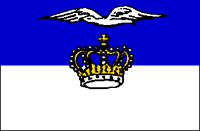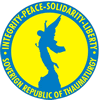|
In our article "The Race of the South East Asian countries for Spratly islands"(1) we described already the geography and geopolitical importance of the Spratly islands and we mentioned the competitive territorial claims and occupations of South East Asian countries in this sea area.
As is well known, palm islands invite to dreaming "to be a king of Tonga" and perhaps these dreams include the beautifulbizarre imagination to be a king or president on such a small island archipelago. That such an idea is not only fiction is shown in the following. We are talking about mini-states in the area of the Spratly archipelago proclaimed by private persons in the past and also in the presence. The "states" sometimes have come to actual reign, sometimes they were and are only head-births or only putative alleged legal claims. 1. The Kingdom of Humanity and the Republic of Morac-Songhrati Meads 1.1. The monarchical Time In 1877 the British captain James George Meads, who is away with his ship "Modeste" in the South China Sea, discovers (3) the main island of Itu Aba. One year later he proclaims himself as King James I. and gives the islands the name "Kingdom of Humanity"(4). The benevolent "Sailor King" King has a mission. His islands should become a home for poor, deprived and suppressed people in Europe and some are following his invitation. In 1888 the year of his death - the kingdom counts nearly two thousand residents. The time of his reign is described as peaceful. British and French sailors can go ashore. Further expansion plans in direction of northern Borneo fail, however, because of the resistance of a local Rajah. And Kris pirates are endangering permanently the little kingdom. His son King George I. (1888-1914) follows him in the reign. It is said, that he was a good diplomat. Nevertheless the treaty of Southwark (1893) regulates that from now on the islands are a British protectorate. So he and his followers - even if they are kings - have only a limited sovereignty. This is also underlined by the fact, that in the historical part of the book "Disputed Islands in the South China Sea" of Dieter Heinzig (5) not even one of the Mead kings is mentioned.
The title of a king is now transferred to the much younger son Morton F. Meads, but he gets the political power only years later because of his youth. Meanwhile, a sultan with name "Songhrati", which lives in the former Dutch east India, has sold property-rights of some islands to the sister of the Philippine president Magsaysay. Morton Meads buys up these rights to have a better safeguard for his claims. He establishes two commercial companies in Manila to promote the sale of minerals and pearls. In 1955 he is arrested for a short time in Manila and is accused of forgery of stamps. 1.2. The time of the republic Then he is for a longer time out of public attention. It is said, that he bred geese and ducks to sell them to restaurants in Saigon and Manila. Perhaps he is also depressed because there are plans to establish a half autonomous status with the Philippines or Singapore. But more badly now the republicans get a stronger foothold on the islands Leader of the republicans, who consider a kingdom to be a historical relic, is Christopher Schneider. He establishes a rival government in 1959 and calls it the "Republic of Morac-Songhrati Meads". The new flag of the Republic of Morac-Songhrati Meads shows among other things traditional yin yang emblems.
1.3 The military occupation of the islands by neighbouring states Now dark clouds appear at the horizon of the republic. The message of prospective gas and earth oil fields in the area of the Spratly islands in the early seventies arouses the interest of the neighbouring countries. First they send only ships for investigation purposes to the islands. These investigations are demonstrative possessory acts. But then the People's Republic of China, followed by Taiwan, the Philippines, South Vietnam and Malaysia occupy them also with military means. The republic doesn't have any military and condemns the occupation as an illegal and aggressive attack on its national sovereignty. The superpowers don't want to intervene and show indifference. "Those Songhrato lucky enough to survive the invasion were forced from their homes at gunpoint. Many escaped the war zone by taking to the sea in small boats, taking with them only what they could carry (7). In opinion of the representatives of the republic such few Moracians who still stay on the islands, are subjugated, the others their number is estimated on 6700 - decided to live in Diaspora. Most of them live "in poverty" in Australia. 1.4 Efforts to regain the sovereignty An exile government in Australia fights still for the reestablishment of the sovereignty of the former republic. The territorial claim refers to all Spratly elevations especially mentioned are: Meads Island (= Itu Abu) with the capital Southwark (proper name), Boags Atoll, Eliza Cay, Cloma Island, Tomas Islet, Bombay Castle, Coopers Cay, Goring Isle, Putney Shoal, Reschs Reef and Brakespear Shoal. The newspaper "The Southwark Sentinel" serves for communication inside and outside of the community. A university - classified as "First Grade University" was already established in Southwark in times before the invasion. If we follow the given information (6) it is continued as a correspondence university and the studies are free of charge. It is possible to acquire the degree of "Doctor of the University" (D.Univ). It is a little bit astonishing that visas - to pay in the currency "Raal" are necessary for such tourists who don't come from the USA or Australia. How should they control it? The government in exile was and is perhaps still looking for "men and women of good will", who support peace, democracy and justice and help in the fight for the independence of the Republic Morac-Songhrati Meads. There is a contact address for interested people to the "operative of field" (7). However we cant give a guarantee that a response is given. The last topics of the "Southwark Sentinel" shown on the Internet are from November 2000. So it remains an open question whether the government in exile is still existent and continues its fight for independence and getting back the home country. 2. Kalayaan - Freedomland Soon after the Japanese government renounced its claims to the Spratly Islands in 1946, the Philippine government saw an opportunity to claim its possession rights at the UNO. But for a longer time the government in Manila did not follow up the territorial claim. Meanwhile the Philippine citizen Thomas Cloma, lawyer and owner of a fish fleet, sounds out the area. In July 1956 he establishes the protectorate Kalayaan (Freedomsland) with Pagasa as capital. He makes claim to "53" elevations and their fishing grounds. His list is not going into details, but included are the Spratly Islands, the Investigator Shoal, Itu Aba, Pagasa and Nam Yit Islands, West York Island, North Danger Reef and the Mariveles Reef. He appoints himself Chair of the Supreme Council. The design of a flag for the Kalayaan country is not long in coming. He apparently has no ambition to establish an independent republic. The seat of his government is Manila (8). It looks as if his economic interests are prevailing. He plans to open a fish cannery and he wants to exploit the guano deposits. He consults regularly the Philippine presidents Garcia and later Marcos. The Philippine government does not support Cloma officially. But from the beginning, Cloma searches the support of the Philippine government and he is in close consultations with the Philippine presidents Garcia and later Marcos. He has a good reason doing so. Taiwan, the People's Republic of China, South Vietnam, France, Great Britain and the Netherlands are protesting against the new protectorate. Taiwan sends even naval task forces to Itu Aba and maintains the occupation until now. In 1968 Filipino troops are stationed on some of the islands to protect Philippine fishermen from encroachments. After sixteen years of existence Cloma deeds Kalayaan to the Philippines in 1978. Now Kalayaan or Freedomsland becomes a "town" of the Palawan province. And for Cloma remains the simple role of a as a town councillor. The Philippine government considers its action of take-over legal und in accordance with the International Sea Law. It is referring to the principle "res nullius" (right of the first on no-mans land) and reasons of geographical proximity to the Philippines. By the way the Philippine part of the Spratlys counted in 1992 only 12 voters an indication for a very sparse population. All this suggests that Cloma and his "Free Territory of Freedomsland" was only a forerunner and outpost agent for the Philippine governments. An independent state was not intended. Years later the Philippine mail paid Cloma respect with the edition of a special stamp. 3. Principality of Freedomland and Republic of Koneuwe
4. The Republic of Thaumaturgy
The word Thaumaturgy is deduced from the Greek and means miracle work in a narrower sense. But it seems that there are no curious miracle cursers in the background of this republic but brave architects of a "new" state. They are good in planning; nevertheless their thinking appears somehow abstract. The Republic of Thaumaturgy has a very detailed constitution following the principles of a modern democratic welfare state and founded on the rules of law. A presidential office, cabinet and ambassador positions are already assigned. President is Mr. Keith McKenzie and the 1985 born Peter Graef Luckett takes the responsibilities of a prime minister. It is a little bit astonishing that the home page of republic refers also to the futility of some efforts in his past: "Mr. Luckett's first attempt at micro-statecraft was the Kingdom of Tarsicia, which in the end gained a total of eleven citizens, stretching from Mississippi to Virginia and even into Greece. After three years of existence, Tarsicia finally folded because of inactivity and the apathy of its citizens". The republic offers a lot of diplomatic positions. The Republic has two for example two ambassadors in Germany one for northern Germany, the other for southern Germany. Thats unusual. On their homepage the representatives are luring with diplomatic passports and privileges. "The qualified candidate will be enable to get an honorary diplomatic position plus the necessary diplomatic immunities". Should there also be a commercial interest in selling such titles? The constitution emphasises the protection of private property. Investments are highly welcome. 100,000 "Peace Bond" papers ( 10 each) have been offered in 2004. "Thau" citizenship if one drew 250 pieces, then one could be granted the "Thau" citizenship is awarded to each applicant, who buys 250 pieces. The subscription of 50-100 bonds entitled the right to hold residency on SRT-islands. The Antarctic Deception Island is also regarded as an SRT-island. The claimed, wedge shaped area stretches from the west coast of Malaysia and Brunei. It includes the Louisa-Reef with the capital "Mother Teresa City" as well as 14 islands and elevations claimed and partly occupied by other countries on which the from outside states impose claims of ownership (Vietnam: 8; Malaysia: 4; Philippines: 2). With regard to the Spratlys the territorial claim refers to the complete Spratly archipelago. The representatives concede however that all claimed islands are occupied by other countries. The explanations of the Spratly archipelago on the homepage are scanty and are mostly based on other sources. No information was available with regard to the relationships to the Republic of Morac-Songhrati Meads and its representatives. But in the text there is a reference to the history of this republic. We find an assurance that the national sovereignty should only be achieved with peaceful means, on the other side hand they have a very detailed armed forces planning. There is a Ministry of Defence and a Security Service. The introduction of a compulsory military service for all men is already decided and a military academy is in planning. We hear that there shall be 15 military provinces, three "Jaeger" brigades, an air force as well as navy. The claimed, wedge shaped area is situated west of Malaysia and Brunei. It includes the Louisa-Reef with the capital "Mother Teresa City" as well as 14 islands and elevations, claimed or occupied by other Asian countries (Vietnam: 8; Malaysia: 4; Philippines: 2). 5. Are there any future chances? Kalayaan (Freedomland) got integrated into the Philippine state and does not exist anymore. The Principality of Freedomland and the republic of Koneuwe was an invention of a confidence trickster. The existence of the Republic of Morac-Songhrati Meads should still be checked. So the question refers only to the Republic of Thaumaturgy. The classic South East Asian countries made claims on all important islands and islets in the Spratly area and they protect them partly by their military. With regard to their growing energy consumption they will not renounce their claims as long as the assumed 17.7 bn barrels of gas and oil (10) in the Spratly area are not exploited. (For comparison - in Kuwait the still existing energy reserve is estimated to 13 bn tons.) The very short text reference to the area and his residents gives the impression that the Republic of Thaumaturgy is perhaps only a state artefact with an interchangeable area. May be that other economic reasons are behind the projects of Republic of Thaumaturgy. The republic doesn't have enough military potential to practise political or military pressure on the other countries and the declared number of 6700 mandatory-emigrants seems too small to mobilize the conscience of the world public in favour of a return. In addition, the leadership of the Republic of Thaumaturgy cannot refer to any specific legal title which gives them sovereignty rights. At present, not even at the best will realistic chances can be seen for the realization of an independent micro state in the Spratly archipelago. But the situation could change in a distant future, when the oil and gas reserves are exhausted and the Spratly islands are returning again to a windswept, flat and sandy nature. And if there is no pollution and destruction perhaps some of the atolls and elevations can be bought for little money. © Wolfgang Bethge in 2005 (1) W. Bethge, the race of the south East Asian states around the Spratly islands, in: http://bethge.freeage.de/spratlydeutsch. htm (2) http://cat.middlebury.edu/southchinasea/macand/alfabetical.htm (3) There are also traces of earlier Chinese and Vietnamese presence in the area (4) So http://The History of the Republic of Morac-Songhrat-Meads.htm According to http://www.zyworld.com/tallini/cesidio/RepublicsoftheReefs.htm Great-grandchild Franklin was the first declared king in 1914 (5) Dieter Heinzig, Disputed Islands in the South China Sea, Wiesbaden, 1976 (6) Till now, the "Republic of Morac-Songhrati Meads" is only recognized by a few, relatively unknown secession states, e.g. by Eastern Turkistan, Chechen Republic Ichkeria, The Holy Empire of Reunions, Tibet or West Sahara (7) http://www.angelfire.com/ri/songhrati/history.html (8) http://www.angelfire.com/songhrati/duniv.htm (9) Dieter Heinzig, Disputed Islands in the South China Sea, Wiesbaden, 1976, p. 36 (10)mailto : [email protected] (11)With reference to David Martucci, Principality of Freedomland and Republic of Koneuwe, http://fotw.fivestarflags.com/xp-s.html (12)With reference to: http://republic-of-thaumaturgy.tk/ (13) http://www.american.edu/projects/mandala/TED/ice/spratly.htm |
 We
should only outline that the west of Palawan situated Spratly Islands show
round about 500-600 scattered, mostly uninhabited little island,
coral-reefs, atolls and rock needles. The total area of the elevations is
less than 50 square kilometres. Only seven main islands have an area of
more than 0.5 km2. Apart from the presumed richness of natural
gas- and oil deposits in the coasts proximities the islands have only a
small economic importance (fishing industry, sites of guano deposits to a
height up to 1 metre). Nevertheless they have important ecological
functions and strategic value with regard of control of shipping to the
Far East. Up to the end of the 2nd World War the Spratly
islands have been politically nearly insignificant, even if there have
been early diplomatic struggles between France, China and Japan. The
situation changed with the military withdrawal of the Japanese troops from
some of the main islands and with the explorations for gas and oil in the
sixties. A list (2) published in 1999 shows 78 bigger
elevations in the Spratly area. Of these 78 islands or should we say
better say elevations - 52 are "occupied" by the following countries:
Vietnam (24), People's Republic of China (14), Philippines (7), Malaysia
(5), and Taiwan (2). So far the current economic and power-political
situation which is, however, not in the attention of this article.
We
should only outline that the west of Palawan situated Spratly Islands show
round about 500-600 scattered, mostly uninhabited little island,
coral-reefs, atolls and rock needles. The total area of the elevations is
less than 50 square kilometres. Only seven main islands have an area of
more than 0.5 km2. Apart from the presumed richness of natural
gas- and oil deposits in the coasts proximities the islands have only a
small economic importance (fishing industry, sites of guano deposits to a
height up to 1 metre). Nevertheless they have important ecological
functions and strategic value with regard of control of shipping to the
Far East. Up to the end of the 2nd World War the Spratly
islands have been politically nearly insignificant, even if there have
been early diplomatic struggles between France, China and Japan. The
situation changed with the military withdrawal of the Japanese troops from
some of the main islands and with the explorations for gas and oil in the
sixties. A list (2) published in 1999 shows 78 bigger
elevations in the Spratly area. Of these 78 islands or should we say
better say elevations - 52 are "occupied" by the following countries:
Vietnam (24), People's Republic of China (14), Philippines (7), Malaysia
(5), and Taiwan (2). So far the current economic and power-political
situation which is, however, not in the attention of this article. After
his death in 1914 his son becomes successor as King Franklin I. He likes
to demonstrate his royal status. Now the South Chinese Sea is called
"Humanity Sea" according to the name of his kingdom. He designs a flag for
his kingdom, establishes a university and he tries to develop the
infrastructure also on remote islets. Now the kingdom has nearly seven
thousand residents. In the spring of 1933, French troops are occupying two
main islands. Franklin I. has to accept the annexation. His kingdom is
more threatened by a Japanese invasion in 1939. The king decides to
evacuate to Australia. When the Japanese are marching in, the royal island
grenadiers left under the conduct of a nephew get executed. Itu Aba is
converted in a submarine basis. In 1945 Franklin I. dies. Throne-successor
should become his son Josiah; but Josiah wants to be crowned only on
Spratly. Before departure he gets malaria and passes away.
After
his death in 1914 his son becomes successor as King Franklin I. He likes
to demonstrate his royal status. Now the South Chinese Sea is called
"Humanity Sea" according to the name of his kingdom. He designs a flag for
his kingdom, establishes a university and he tries to develop the
infrastructure also on remote islets. Now the kingdom has nearly seven
thousand residents. In the spring of 1933, French troops are occupying two
main islands. Franklin I. has to accept the annexation. His kingdom is
more threatened by a Japanese invasion in 1939. The king decides to
evacuate to Australia. When the Japanese are marching in, the royal island
grenadiers left under the conduct of a nephew get executed. Itu Aba is
converted in a submarine basis. In 1945 Franklin I. dies. Throne-successor
should become his son Josiah; but Josiah wants to be crowned only on
Spratly. Before departure he gets malaria and passes away. But
the two states merge in 1963. Christopher Schneider becomes the chef of
state. Morton F. Mead has to give up the title as king and becomes
ambassador at the United Nations. Now he is engaged - mostly without
success (6) - in the fight for the international diplomatic
recognition of the republic. In 1972 a catastrophe occurs. The head of
state Mr. Schneider and all cabinet members are drown when their sail ship
sinks in a typhoon storm at Mindoro Island.
But
the two states merge in 1963. Christopher Schneider becomes the chef of
state. Morton F. Mead has to give up the title as king and becomes
ambassador at the United Nations. Now he is engaged - mostly without
success (6) - in the fight for the international diplomatic
recognition of the republic. In 1972 a catastrophe occurs. The head of
state Mr. Schneider and all cabinet members are drown when their sail ship
sinks in a typhoon storm at Mindoro Island.  Little
- nevertheless illustrious is known about this principality. In 1974 the
French police arrested a "swindler", who called himself pretentiously
"Grand Duke of the Principality Freedomland Count Othmar di Schmieder
Rocca Forozata". The name Freedomland indicates Clomas Freedomland, but
there is no evidence of a relationship between the two. The defrauder
mentioned only that his territory encompasses 74 islands and would be
located 2000 km away from Borneo. The flag of the claimed principality
shows a crown and an albatross on a blue white background. We should still
remark that the name of his country includes a contradiction. With
reference to the general theory of state a "Principality" cant be a
"Republic" (8) .
Little
- nevertheless illustrious is known about this principality. In 1974 the
French police arrested a "swindler", who called himself pretentiously
"Grand Duke of the Principality Freedomland Count Othmar di Schmieder
Rocca Forozata". The name Freedomland indicates Clomas Freedomland, but
there is no evidence of a relationship between the two. The defrauder
mentioned only that his territory encompasses 74 islands and would be
located 2000 km away from Borneo. The flag of the claimed principality
shows a crown and an albatross on a blue white background. We should still
remark that the name of his country includes a contradiction. With
reference to the general theory of state a "Principality" cant be a
"Republic" (8) . There
is only little information about this republic. All information we have
are collected from the homepage of the representatives of the republic.
We found no external (critical) material.
There
is only little information about this republic. All information we have
are collected from the homepage of the representatives of the republic.
We found no external (critical) material. 